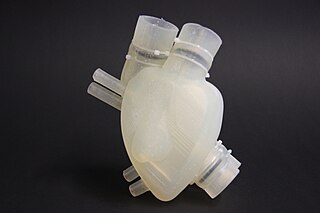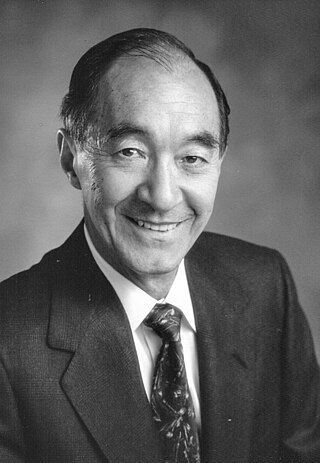Related Research Articles

Endocrinology is a branch of biology and medicine dealing with the endocrine system, its diseases, and its specific secretions known as hormones. It is also concerned with the integration of developmental events proliferation, growth, and differentiation, and the psychological or behavioral activities of metabolism, growth and development, tissue function, sleep, digestion, respiration, excretion, mood, stress, lactation, movement, reproduction, and sensory perception caused by hormones. Specializations include behavioral endocrinology and comparative endocrinology.

William Castle DeVries is an American cardiothoracic surgeon, mainly known for the first transplant of a TAH using the Jarvik-7 model.
An artificial organ is a human made organ device or tissue that is implanted or integrated into a human — interfacing with living tissue — to replace a natural organ, to duplicate or augment a specific function or functions so the patient may return to a normal life as soon as possible. The replaced function does not have to be related to life support, but it often is. For example, replacement bones and joints, such as those found in hip replacements, could also be considered artificial organs.

An artificial heart is a device that replaces the heart. Artificial hearts are typically used to bridge the time to heart transplantation, or to permanently replace the heart in the case that a heart transplant is impossible. Although other similar inventions preceded it from the late 1940s, the first artificial heart to be successfully implanted in a human was the Jarvik-7 in 1982, designed by a team including Willem Johan Kolff, William DeVries and Robert Jarvik.

Experiments in the Revival of Organisms is a 1940 motion picture, directed by David Yashin, that documents Soviet research into the resuscitation of clinically dead organisms. The operations in the film, as well as the design of the heart-lung machine demonstrated in it, the autojektor, were done by Sergei Brukhonenko, whose work in the film is said to have led to the first operations on heart valves.
Robert Koffler Jarvik is an American scientist, researcher, and entrepreneur known for his role in developing the Jarvik-7 artificial heart.

Extracorporeal membrane oxygenation (ECMO), also known as extracorporeal life support (ECLS), is an extracorporeal technique of providing prolonged cardiac and respiratory support to persons whose heart and lungs are unable to provide an adequate amount of gas exchange or perfusion to sustain life. The technology for ECMO is largely derived from cardiopulmonary bypass, which provides shorter-term support with arrested native circulation. The device used is a membrane oxygenator, also known as an artificial lung.
An extracorporeal is a medical procedure which is performed outside the body. Extracorporeal devices are the artificial organs that remain outside the body while treating a patient. Extracorporeal devices are useful in hemodialysis and cardiac surgery.

Sergei Sergeevich Brukhonenko was a Soviet physician, biomedical scientist and technologist during the Stalinist era. Brukhonenko's research was vital to the development of open-heart procedures in Russia. He was one of the leaders of the Research Institute of Experimental Surgery, where Professor Alexander Vishnevsky performed the first Soviet open-heart operation in 1957.
Artificial kidney is often a synonym for hemodialysis, but may also refer to the other renal replacement therapies that are in use and/or in development. This article deals mainly with bioengineered kidneys/bioartificial kidneys that are grown from renal cell lines/renal tissue.

Organ printing utilizes techniques similar to conventional 3D printing where a computer model is fed into a printer that lays down successive layers of plastics or wax until a 3D object is produced. In the case of organ printing, the material being used by the printer is a biocompatible plastic. The biocompatible plastic forms a scaffold that acts as the skeleton for the organ that is being printed. As the plastic is being laid down, it is also seeded with human cells from the patient's organ that is being printed for. After printing, the organ is transferred to an incubation chamber to give the cells time to grow. After a sufficient amount of time, the organ is implanted into the patient.
Gerson "Gus" Rosenberg, Ph.D., is an American biomedical engineer. He is the Jane A. Fetter Professor of Surgery, professor of bioengineering, and chief of the Division of Applied Biomedical Engineering at Penn State's Milton S. Hershey Medical Center and Penn State College of Medicine.
Dr. Bill Dobelle was a biomedical researcher who developed experimental technologies that restored limited sight to blind patients, and also known for the impact he and his company had on the breathing pacemaker industry with the development of the only FDA approved device for phrenic nerve pacing. He was the former director of the Division of Artificial Organs at the Columbia-Presbyterian Medical Center.

Willem Johan "Pim" Kolff was a pioneer of hemodialysis, artificial heart, as well as in the entire field of artificial organs. Willem was a member of the Kolff family, an old Dutch patrician family. He made his major discoveries in the field of dialysis for kidney failure during the Second World War. He emigrated in 1950 to the United States, where he obtained US citizenship in 1955, and received a number of awards and widespread recognition for his work.

A membrane oxygenator is a device used to add oxygen to, and remove carbon dioxide from the blood. It can be used in two principal modes: to imitate the function of the lungs in cardiopulmonary bypass (CPB), and to oxygenate blood in longer term life support, termed extracorporeal membrane oxygenation (ECMO). A membrane oxygenator consists of a thin gas-permeable membrane separating the blood and gas flows in the CPB circuit; oxygen diffuses from the gas side into the blood, and carbon dioxide diffuses from the blood into the gas for disposal.

A heart transplant, or a cardiac transplant, is a surgical transplant procedure performed on patients with end-stage heart failure or severe coronary artery disease when other medical or surgical treatments have failed. As of 2018, the most common procedure is to take a functioning heart, with or without both lungs, from a recently deceased organ donor and implant it into the patient. The patient's own heart is either removed and replaced with the donor heart or, much less commonly, the recipient's diseased heart is left in place to support the donor heart.

Theodosios Alexander is an American academic, engineer and author. He has served as faculty and in academic administration in four universities, in the UK and USA, following the award of four graduate degrees from MIT, and work in engineering industry.

Clifford Stanley Kwan-Gett is an Australian-born Chinese American engineer, physician, and artificial heart pioneer.
The ASAIO Journal is a peer-reviewed medical journal covering research and development of artificial organs. It is published by Wolters Kluwer on behalf of the American Society for Artificial Internal Organs (ASAIO) and the editor-in-chief is Mark S. Slaughter, MD. It was established in 1955 as the Transactions of the American Society for Artificial Internal Organs to publish the proceedings of the annual ASAIO conference. It obtained its current title in 1992. The journal publishes monthly.

Cara Wrigley is an Australian industrial designer, design researcher and author. She is professor of design innovation at The University of Queensland. Her research interests include design thinking, design-led innovation, design education, and emotional design.
References
- ↑ "ASAIO - American Society for Artificial Internal Organs". asaio.org. Retrieved 2020-10-26.
- ↑ ASAIO - 66th Annual Conference
- ↑ "About the Journal". journals.lww.com. Retrieved 2020-10-29.